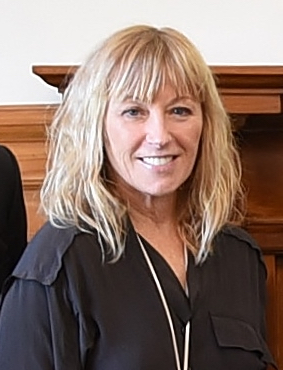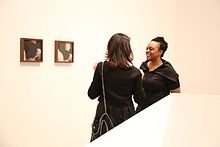
Catherine Sue Opie is an American fine-art photographer and educator. She lives and works in Los Angeles, as a professor of photography at University of California at Los Angeles.

Vija Celmins is a Latvian American visual artist best known for photo-realistic paintings and drawings of natural environments and phenomena such as the ocean, spider webs, star fields, and rocks. Her earlier work included pop sculptures and monochromatic representational paintings. Based in New York City, she has been the subject of over forty solo exhibitions since 1965, and major retrospectives at the Museum of Modern Art, Whitney Museum of American Art, Los Angeles County Museum of Art, San Francisco Museum of Modern Art, Institute of Contemporary Arts, London and the Centre Pompidou, Paris.

Cynthia Morris Sherman is an American artist whose work consists primarily of photographic self-portraits, depicting herself in many different contexts and as various imagined characters.
Sherrie Levine is an American photographer, painter, and conceptual artist. Some of her work consists of exact photographic reproductions of the work of other photographers such as Walker Evans, Eliot Porter and Edward Weston.

Robert Gober is an American sculptor. His work is often related to domestic and familiar objects such as sinks, doors, and legs.
Rachel Harrison is an American visual artist known for her sculpture, photography, and drawing. Her work often combines handmade forms with found objects or photographs, bringing art history, politics, and pop culture into dialogue with one another. She has been included in numerous exhibitions in Europe and the US, including the Venice Biennale, the Whitney Biennial and the Tate Triennial (2009). Her work is in the collections of major museums such as The Museum of Modern Art, New York; Metropolitan Museum of Art, New York; Hirshhorn Museum and Sculpture Garden, Washington, D.C.; and Tate Modern, London; among others. She lives and works in New York.

Roni Horn is an American visual artist and writer. The granddaughter of Eastern European immigrants, she was born in New York City, where she lives and works. She is currently represented by Xavier Hufkens in Brussels and Hauser & Wirth. She is openly gay.
Michelle Stuart is an American multidisciplinary artist known for her sculpture, painting and environmental art. She is based in New York City.
James Welling is an American artist, photographer and educator living in New York City. He attended Carnegie-Mellon University where he studied drawing with Gandy Brodie and at the University of Pittsburgh where he took modern dance classes. Welling transferred to the California Institute of the Arts in Valencia, California in 1971 and received a B.F.A. and an M.F.A. in the School of Art. At Cal Arts, he studied with John Baldessari, Wolfgang Stoerchle and Jack Goldstein.

Zoe Leonard is an American artist who works primarily with photography and sculpture. She has exhibited widely since the late 1980s and her work has been included in a number of seminal exhibitions including Documenta IX and Documenta XII, and the 1993, 1997 and 2014 Whitney biennials. She was awarded a Guggenheim Fellowship in 2020.
Dike Blair is a New York-based artist, writer and teacher. His art consists of two parallel bodies of work: intimate, photorealistic paintings and installation-like sculptures assembled from common objects—often exhibited together—which examine overlooked and unexceptional phenomena of daily existence in both a romantic and ironic manner. Blair emerged out of the late 1970s New York art scene, and his work relates to concurrent movements such as the Pictures Generation, Minimalism and conceptual art, while remaining distinct from and tangential to them. New York Times critic Roberta Smith places his sculpture in a "blurred category" crossing "Carl Andre with ikebana, formalist abstraction with sleek anonymous hotel rooms, talk-show sets with home furnishings showrooms." Cameron Martin writes in Artforum that the paintings are "rendered with a lucidity that extracts something metaphysical from the mundane."

Elad Lassry is an American artist who lives and works in Los Angeles.
Laura Owens is an American painter, gallery owner and educator. She emerged in the late 1990s from the Los Angeles art scene. She is known for large-scale paintings that combine a variety of art historical references and painterly techniques. She lives and works in Los Angeles, California.
Charles Gaines is an American artist whose work interrogates the discourse of aesthetics, politics, and philosophy. Taking the form of drawings, photographic series and video installations, the work consistently involves the use of systems, predominantly in the form of the grid, often in combination with photography. His work is rooted in Conceptual Art – in dialogue with artists such as Sol LeWitt, Lawrence Weiner and Mel Bochner – and Gaines is committed to its tenets of engaging cognition and language. As one of the only African-American conceptual artists working in the 1970s, a time when political expressionism was a prevailing concern among African-American artists, Gaines was an outlier in his pursuit of abstraction and non-didactic approach to race and politics. There is a strong musical thread running through much of Gaines' work, evident in his repeated use of musical scores as well in his engagement with the idea of indeterminacy, as similar to John Cage and Sol LeWitt.
Luisa Lambri is an Italian artist working with photography and film, based in Milan. Her photographs are often based on architecture and abstraction.

Piotr Uklański is a contemporary Polish-American artist who has produced art since the mid 1990s which have explored themes of spectacle, cliche, and tropes of modern art. Many of his pieces and projects take well-known, overused, sometimes sentimental subjects and tropes and both embraces and subverts them. Untitled (1996) is one of his best known works which took a minimalist grid floor in the gallery and developed it into a disco dance floor activated with sound and lit with bright colors. His works have been featured at the Museum of Modern Art in New York, Migros Museum of Contemporary Art in Zurich, Museum of Modern and Contemporary Art in Strasbourg, and Whitney Museum of American Art in New York.
Miranda Lichtenstein is an American artist focusing on photography and video.
Ruth Thorne-Thomsen is an American photographer who resides in Philadelphia. Important collections of her work are held by the Philadelphia Museum of Art, the Nelson-Atkins Museum, and the Art Institute of Chicago. She was married to the photographer Ray K. Metzker until his death in 2014.
Frances Barth is an American visual artist best known for paintings situated between abstraction, landscape and mapping, and in her later career, video and narrative works. She emerged during a period in which contemporary painters sought a way forward beyond 1960s minimalism and conceptualism, producing work that combined modernist formalism, geometric abstraction, referential elements and metaphor. Critic Karen Wilkin wrote, "Barth’s paintings play a variety of spatial languages against each other, from aerial views that suggest mapping, to suggestions of perspectival space, to relentless flatness … [she] questions the very pictorial conventions she deploys, creating ambiguous imagery and equally ambiguous space that seems to shift as we look."








